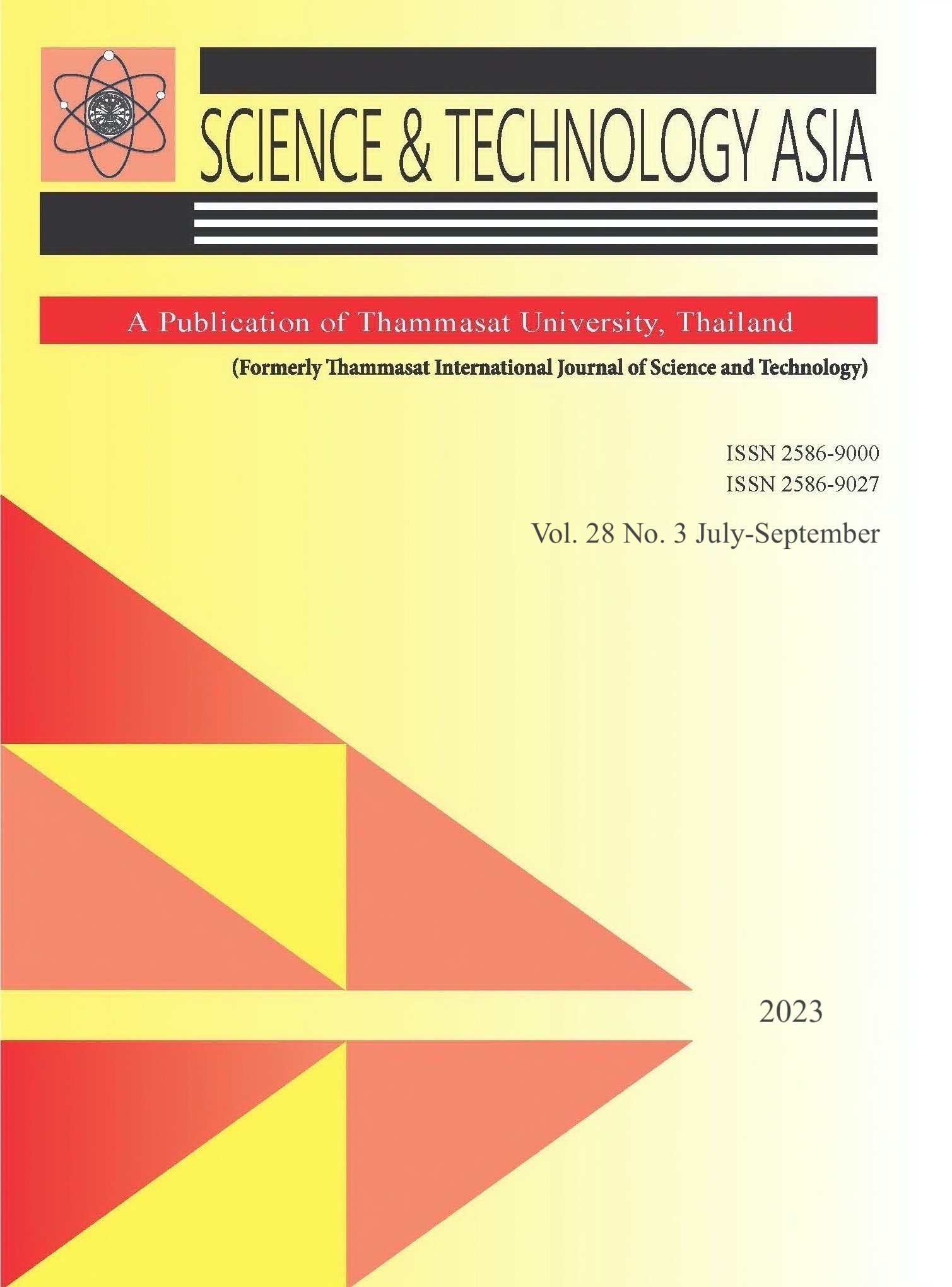Biotransformation of Gingerol-Related Compounds in Ginger Rhizome Extract with Selected Species of Aspergillus, Monacus and Penicillium
Main Article Content
Abstract
The simultaneous biotransformation of gingerol-related compounds in ginger extract was performed by Aspergillus niger, A. flavas, Monacus purpureus and Penicilium funiculosum. Ginger metabolites and their substrates from the biotransformation were characterized by HPLC and HPLC-QTOF-MS. GM-1, GM-2 and GM-3 were converted from [6]-gingerol and [6]-shogaol, the main constituents found in the ginger extract, by both strains of A. niger after a 24-h fermentation period. Meanwhile, P. funiculosum was able to produce GM-2 and GM-3. The enzymatic reactions of the substrate molecules included the reduction of ketone groups as well as hydroxylation of terminal alkyl side chains. The levels of almost all gingerol-related compounds in the cultivation medium of all fungi, were decreased. There was no metabolite derived from the other compounds in the homologous series of gingerols and shogaols according to the mentioned reactions. In conclusion, the present study verified that simultaneous biotransformation was an effective technique to produce a variety of active metabolites and the crude extract from natural products can be applied to biotransformation studies without any isolation or purification steps for each substrate.
Article Details

This work is licensed under a Creative Commons Attribution-NonCommercial-NoDerivatives 4.0 International License.
References
Ali BH, Blunden G, Tanira MO, Nemmar A. Some phytochemical, pharmacological and toxicological properties of ginger (Zingiber officinale Roscoe): A review of recent research. Food Chem Toxicol 2008;46(2):409-20.
Mashhadi NS, Ghiasvand R, Askari G, Hariri M, Darvishi L, Mofid MR. Anti-oxidative and anti-inflammatory effects of ginger in health and physical activity: Review of current evidence. Int J Prev Med 2013;4(1):S36-42.
Jolad SD, Lantz RC, Solyom AM, Chen GJ, Bates RB, Timmermann BN. Fresh organically grown ginger (Zingiber officinale): composition and effects on LPS-induced PGE2 production. Phytochemistry 2004;65(13):1937-54.
Prasad S, Tyagi AK. Ginger and its constituents: role in prevention and treatment of gastrointestinal cancer. Gastroent Res Pract 2015;142979.
Mao QQ, Xu XY, Cao SY, Gan RY, Corke H, Beta T, Li HB. Bioactive compounds and bioactivities of ginger (Zingiber officinale Roscoe). Foods 2019;8(6):185.
Tao Y, Li W, Liang W, Breemen RB. Identification and quantification of gingerols and related compounds in ginger dietary supplements using high performance liquid chromatography-tandem mass spectrometry. J Agric Food Chem 2009;57(21):10014-21.
Semwal RB, Semwal K, Combrinck S, Viljoen AM. Gingerols and shogaols: important nutraceutical principles from ginger. Phytochemistry 2015;117:554-68.
Cheng XL, Liu Q, Peng YB, Qi LW, Li P. Steamed ginger (Zingiber officinale): Changed chemical profile and increased anticancer potential. Food Chem 2011;129(4):1785-92.
Hegazy MF, Mohamed TA, ElShamy AI, Mohamed AH, Mahalel UA, Reda EH, Shaheen AM, Tawfik WA, Shahat AA, Shams KA, Abdel-Azim NS, Hammouda FM. Microbial biotransformation as a tool for drug development based on natural products from mevalonic acid pathway: A review. J Adv Res 2015;6(1):17-33.
Aldarra HY, Oma, MN. Microbial transformation of natural products. Greener J Biol Sci 2013;3(10):357-64.
Takahashi H, Hashimoto T, Noma Y, Asakawa Y. Biotransformation of 6-gingerol and 6-shogaol by Aspergillus niger. Phytochemistry 1993;34(6):497-1500. https://doi.org/10.1016/S0031-9422(00)90835-5.
Lee SS. Re-examination of 6-shogaol biotransformation by Aspergillus niger. Arch Pharm Res 1995;18(2):136-7.
Jo SK, Kim IS, Rehman SU, Ha SK, Park HY, Park YK, Yoo HH. Characterization of metabolites produced from the biotransformation of 6-shogaol formed by Aspergillus niger. Eur Food Res Technol. 2016;242(1):137-142. https://doi.org/10.1007/s00217-015-2519-6.
Lee SS, Lee WY. Biotransformation of dehydroparadols by Aspergillus niger. Arch Pharm Res 1995;18(6):458-61.
Ok S, Jeong WS. Optimization of extraction conditions for the 6-shogaol-rich extract from ginger (Zingiber officinale Roscoe). Prev Nutr Food Sci 2012;17(2):166-71.
Sang S, Snook H D, Tareq FS. Fasina Y. Precision research on ginger: the type of ginger matters. J Agri Food Chem 2020;68(32):8517-23.
Park JS, Jung MY. Development of high-performance liquid chromatography-time-of-flight mass spectrometry for the simultaneous characterization and quantitative analysis of gingerol-related compounds in ginger products. J Agric Food Chem 2012;60(40):10015-26.
Park SY, Jung M Y. UHPLC-ESI-MS/MS for the quantification of eight major gingerols and shogaols in ginger products: effects of ionization polarity and mobile phase modifier on the sensitivity. J Food Sci 2016; 81(10):C2457-65.
Schuster E, Dunn-Coleman N, Frisvad J, Van Dijck P. On the safety of Aspergillus niger-a review. Appl Microbial Biotechnol 2002;59(4-5):426-35.
Jiang H, Solyom AM., Timmermann BN, Gang DR. Characterization of gingerol-related compounds in ginger rhizome (Zingiber officinale Rosc.) by high-performance liquid chromatography/electrospray ionization mass spectrometry. Rapid Commun Mass Spectrom 2005;19(20):2957-64.


